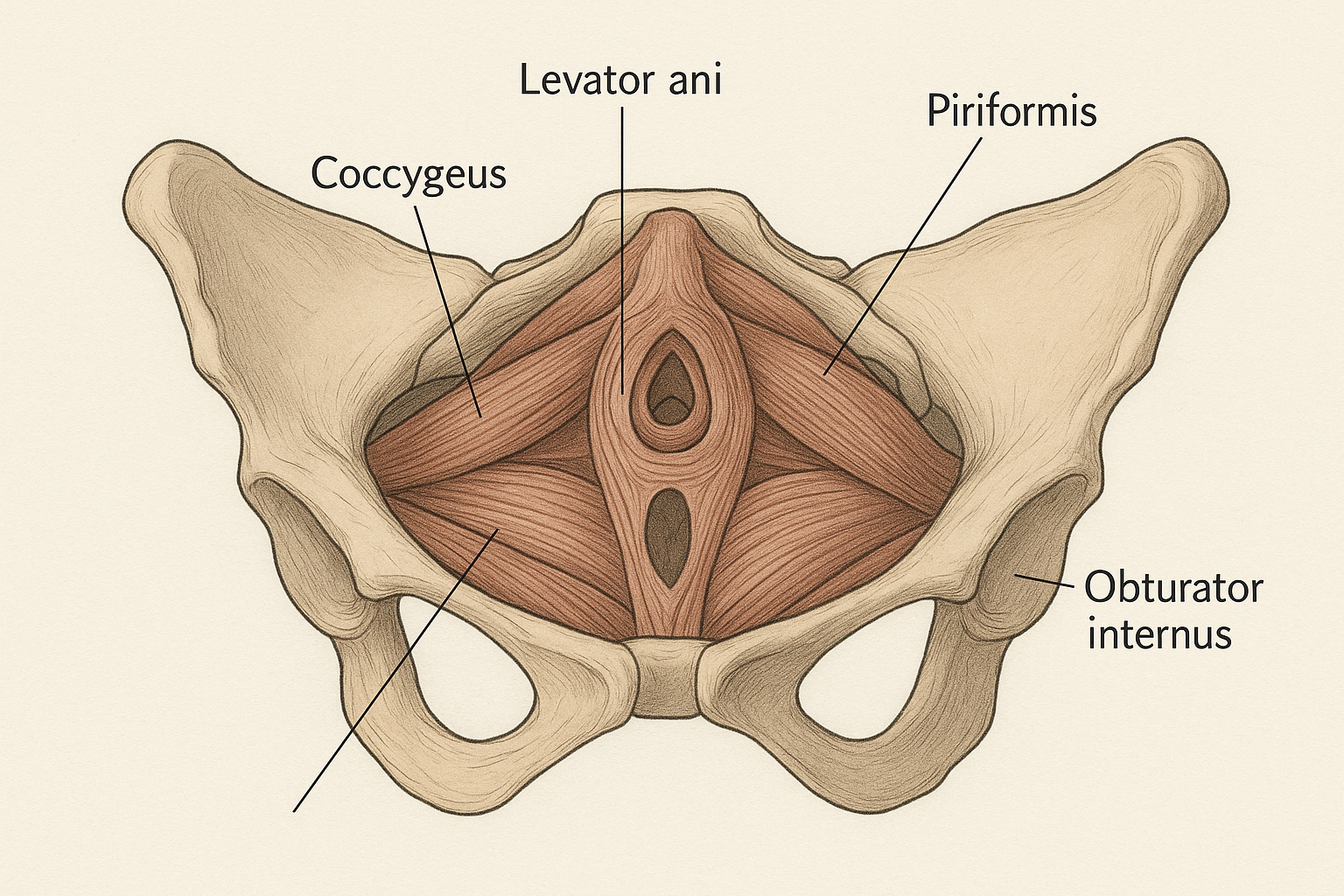Understanding Your Pelvic Floor Muscles: Anatomy and Function
Written by certified pelvic health physical therapists. Medically reviewed by board-certified specialists in urogynecology.

Detailed anatomical illustration of the pelvic floor muscles
What is the Pelvic Floor?
The pelvic floor consists of layers of muscles and tissues that stretch like a hammock from the pubic bone in front to the coccyx (tailbone) at the back. These muscles and tissues support the pelvic organs, including the bladder, intestines, and uterus (in women).
Recent research has emphasized the importance of these muscles not just for bladder and bowel control, but also for core stability, sexual function, and overall quality of life [1].
Anatomy of the Pelvic Floor
The pelvic floor muscles include several key muscle groups:
- Levator ani: The largest muscle group of the pelvic floor, consisting of the puborectalis, pubococcygeus, and iliococcygeus muscles.
- Coccygeus: A triangular muscle that supports the coccyx and lower sacrum.
- Superficial perineal muscles: Including the bulbospongiosus, ischiocavernosus, and superficial transverse perineal muscles.
- Anal sphincter complex: The internal and external anal sphincters.
- Urethral sphincter complex: The intrinsic and extrinsic urethral sphincters.
A landmark study by DeLancey (2005) provided detailed insights into how these muscles function together to maintain pelvic organ support [2]. More recent imaging studies have enhanced our understanding of the three-dimensional nature of these muscle groups and their coordinated action [3].
Functions of the Pelvic Floor
The pelvic floor muscles serve several critical functions:
Support
The pelvic floor provides crucial support for the pelvic organs against gravity and increases in intra-abdominal pressure. This support is essential for preventing pelvic organ prolapse, a condition where organs descend from their normal position.
Sphincter Function
These muscles help maintain continence by controlling the release of urine and feces. The pubococcygeus portion of the levator ani and the external urethral sphincter are particularly important for urinary continence.
Sexual Function
The pelvic floor muscles play a significant role in sexual function for both men and women. In women, these muscles contract during orgasm and contribute to vaginal sensation. In men, they contribute to erectile function and ejaculation.
Stability
Along with the transversus abdominis, diaphragm, and multifidus, the pelvic floor contributes to core stability and intra-abdominal pressure regulation, which is important for spine stabilization during movement.
Common Pelvic Floor Disorders
Dysfunction of the pelvic floor can lead to various conditions, including:
- Stress urinary incontinence: Leakage of urine during activities that increase abdominal pressure
- Pelvic organ prolapse: Descent of pelvic organs from their normal position
- Fecal incontinence: Inability to control bowel movements
- Chronic pelvic pain: Persistent pain in the pelvic region
- Sexual dysfunction: Including pain during intercourse (dyspareunia)
A systematic review by Wu et al. (2018) found that pelvic floor muscle training is effective as a first-line treatment for many of these conditions [4].
Importance of Pelvic Floor Exercises
Regular pelvic floor muscle training (Kegel exercises) can help:
- Prevent or reduce urinary and fecal incontinence
- Support recovery after childbirth
- Improve sexual function and satisfaction
- Provide support before and after pelvic surgery
- Enhance core stability and posture
The PelvicFit app offers guided exercises that target these muscles specifically, with programs tailored to different needs and conditions.
Conclusion
Understanding the anatomy and function of your pelvic floor muscles is the first step toward maintaining their health. Whether you're looking to prevent problems, recover from childbirth or surgery, or address existing symptoms, a consistent program of properly performed pelvic floor exercises can significantly improve your quality of life.
References
- Ashton-Miller JA, DeLancey JO. Functional anatomy of the female pelvic floor. Ann N Y Acad Sci. 2007;1101:266-296.
- DeLancey JO. The hidden epidemic of pelvic floor dysfunction: achievable goals for improved prevention and treatment. Am J Obstet Gynecol. 2005;192(5):1488-1495.
- Dietz HP. Pelvic floor ultrasound: a review. Am J Obstet Gynecol. 2010;202(4):321-334.
- Wu YM, McInnes N, Leong Y. Pelvic floor muscle training versus watchful waiting and pelvic floor disorders in women: a systematic review and meta-analysis. Female Pelvic Med Reconstr Surg. 2018;24(2):142-149.